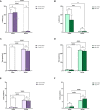Intact maternal buffering of stress response in infant rats despite altered responsivity towards maternal olfactory cues in the valproic acid model of autism-like behavior
- PMID: 36072089
- PMCID: PMC9441625
- DOI: 10.3389/fnbeh.2022.959485
Intact maternal buffering of stress response in infant rats despite altered responsivity towards maternal olfactory cues in the valproic acid model of autism-like behavior
Abstract
Disrupted processing of social cues and altered social behaviors are among the core symptoms of autism spectrum disorders (ASDs), and they emerge as early as the first year of life. These differences in sensory abilities may affect the ability of children with ASDs to securely attach to a caregiver and experience caregiver buffering of stress. Prenatal exposure to valproic acid (VPA) has been used to model some aspects of ASDs in rodents. Here, we asked whether prenatal VPA exposure altered infant rats' behavioral responsivity to maternal olfactory cues in an Odor Preference Test (OPT) and affected maternal buffering of infants' stress responsivity to shock. In the odor preference test, 1-week old rats treated with VPA during pregnancy appeared to have impaired social recognition and/or may be less motivated to approach social odors in early infancy. These effects were particularly prominent in female pups. In 2-week old rats, VPA-exposed pups and saline-exposed pups showed similar preferences for home cage bedding. Although VPA-exposed pups may initially have a deficit in this attachment-related behavior they do recover typical responses to home cage bedding in later infancy. Both control and VPA-exposed pups showed robust stress hormone responses to repeated shocks, an effect which was blocked when a calm mother was present during shock exposure. No sex differences in the effect of maternal presence on the stress response to shock and no interactions between sex and prenatal drug exposure were observed. Although VPA-exposed pups may show impaired responsivity to maternal cues in early infancy, maternal presence is still capable of regulating the stress response in VPA-exposed pups. In this study we demonstrate the importance of utilizing multiple batteries of tests in assessing behavior, dissecting the behavior on one test into different components. Our results inform about the underlying behavioral characteristics of some of the ASD phenotypes, including sex differences reported by clinical studies, and could shed light on potential opportunities for intervention.
Keywords: autism; infancy; maternal buffering; rat; social behavior; valproic acid.
Copyright © 2022 White, An and Debiec.
Conflict of interest statement
The authors declare that the research was conducted in the absence of any commercial or financial relationships that could be construed as a potential conflict of interest.
Figures





Similar articles
-
Effects of prenatal exposure to valproic acid or poly(I:C) on ultrasonic vocalizations in rat pups: The role of social cues.Physiol Behav. 2020 Oct 15;225:113113. doi: 10.1016/j.physbeh.2020.113113. Epub 2020 Jul 30. Physiol Behav. 2020. PMID: 32738314
-
The effect of early handling on anxiety-like behaviors of rats exposed to valproic acid pre-and post-natally.Neurotoxicol Teratol. 2022 Jan-Feb;89:107050. doi: 10.1016/j.ntt.2021.107050. Epub 2021 Nov 18. Neurotoxicol Teratol. 2022. PMID: 34801733
-
Reward-Related Behavioral, Neurochemical and Electrophysiological Changes in a Rat Model of Autism Based on Prenatal Exposure to Valproic Acid.Front Cell Neurosci. 2019 Oct 25;13:479. doi: 10.3389/fncel.2019.00479. eCollection 2019. Front Cell Neurosci. 2019. PMID: 31708750 Free PMC article.
-
Prenatal valproate in rodents as a tool to understand the neural underpinnings of social dysfunctions in autism spectrum disorder.Neuropharmacology. 2019 Nov 15;159:107477. doi: 10.1016/j.neuropharm.2018.12.024. Epub 2019 Jan 9. Neuropharmacology. 2019. PMID: 30639388 Review.
-
Avian models for brain mechanisms underlying altered social behavior in autism.Front Physiol. 2022 Oct 28;13:1032046. doi: 10.3389/fphys.2022.1032046. eCollection 2022. Front Physiol. 2022. PMID: 36388132 Free PMC article. Review.
References
-
- Baio J., Wiggins L., Christensen D. L., Maenner M. J., Daniels J., Warren Z., et al. . (2018). Prevalence of autism spectrum disorder among children aged 8 years - Autism and developmental disabilities monitoring network, 11 Sites, United States, 2014. MMWR Surveill. Summ. 67, 1–23. 10.15585/mmwr.ss6706a1 - DOI - PMC - PubMed
-
- Bolles R. C., Woods P. J. (1964). The ontogeny of behaviour in the albino rat. Anim. Behav. 12, 427–441. 10.1016/0003-3472(64)90062-4 - DOI
LinkOut - more resources
Full Text Sources

